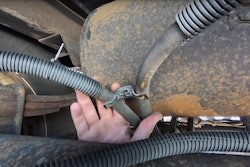The following was published in CCJ's Air Brake Book, 11th edition, sponsored by SilverbackHD. CCJ's Air Brake Book is a complementary industry resource, courtesy of our partnership with SilverbackHD, the Technology and Maintenance Council and Commercial Vehicle Safety Alliance. You can download the entire Air Brake Book here.
A balanced brake system is when the entire brake system, from front to back, (including the tractor and trailer) react at the correct time to produce equal timing and brake pressure.
According to SilverbackHD, brake imbalance can be caused by many factors:
• Disc and drum brakes perform differently, so matching like brake designs will provide more consistent performance.
• Various brands of friction and material types within those brands have different performance characteristics.
• Each friction formula has different stopping power vs other friction formulas
• If different friction formulas are used on different axles (or sides of a vehicle), the brake with the higher coefficient of friction will do more work; the lower friction may gradually glaze over due to lack of work, and the results are unstable braking (or worse); the higher friction wheels will deliver faster wear rates and more stopping power; the lower friction wheels won’t do their share of the work and instability results; and certain brakes, when overworked, can also potentially fade and cause instability under load.
To ensure you have proper brake balance, SilverbackHD suggests the following:
• Challenge your parts supplier to assist you in selecting the right friction for your application.
• Utilize one brand and formula of friction on all axles and wheels on a given tractor trailer combination whenever possible. For instance, a fleet hauling potato chips on the Plains will need a much lighter friction than a refuse or cement hauler running with heavy loads in hilly country or stop and go city. Fleets should understand what friction brand and formula helps them accomplish their maintenance goals and stick with it. New steel shoes will provide the longest life cycle possible for the chosen friction.
• Always perform complete vehicle brake jobs, never one axle or one wheel at a time.
• Resist the temptation to fix symptoms. Look for causes of rapid wear and/or very low wear as compared to other wheels. Dig deep to fix the cause as opposed to just what’s on the surface.
With the exception of a steer axle, all wheels should wear out at the same rate. If that’s not the case, you have a maintenance problem that needs to be found.













